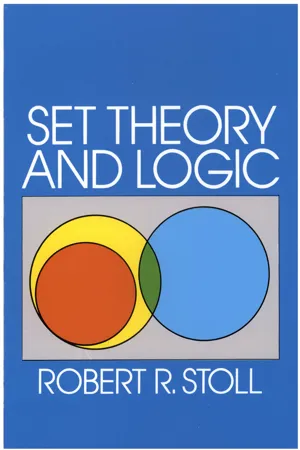
- 512 pages
- English
- ePUB (mobile friendly)
- Available on iOS & Android
Set Theory and Logic
About This Book
Set Theory and Logic is the result of a course of lectures for advanced undergraduates, developed at Oberlin College for the purpose of introducing students to the conceptual foundations of mathematics. Mathematics, specifically the real number system, is approached as a unity whose operations can be logically ordered through axioms. One of the most complex and essential of modern mathematical innovations, the theory of sets (crucial to quantum mechanics and other sciences), is introduced in a most careful concept manner, aiming for the maximum in clarity and stimulation for further study in set logic.
Contents include: Sets and Relations — Cantor's concept of a set, etc.
Natural Number Sequence — Zorn's Lemma, etc.
Extension of Natural Numbers to Real Numbers
Logic — the Statement and Predicate Calculus, etc.
Informal Axiomatic Mathematics
Boolean Algebra Informal Axiomatic Set Theory Several Algebraic Theories — Rings, Integral Domains, Fields, etc.
First-Order Theories — Metamathematics, etc.
Symbolic logic does not figure significantly until the final chapter. The main theme of the book is mathematics as a system seen through the elaboration of real numbers; set theory and logic are seen s efficient tools in constructing axioms necessary to the system.
Mathematics students at the undergraduate level, and those who seek a rigorous but not unnecessarily technical introduction to mathematical concepts, will welcome the return to print of this most lucid work.
"Professor Stoll... has given us one of the best introductory texts we have seen." — Cosmos.
"In the reviewer's opinion, this is an excellent book, and in addition to its use as a textbook (it contains a wealth of exercises and examples) can be recommended to all who wish an introduction to mathematical logic less technical than standard treatises (to which it can also serve as preliminary reading)." — Mathematical Reviews.
Frequently asked questions
Information
Sets and Relations
Table of contents
- Cover
- Title Page
- Copyright Page
- Dedication
- Preface
- Contents
- Chapter 1 Sets and Relations
- Chapter 2 The Natural Number Sequence and its Generalizations
- Chapter 3 The Extension of the Natural Numbers to the Real Numbers
- Chapter 4 Logic
- Chapter 5 Informal Axiomatic Mathematics
- Chapter 6 Boolean Algebras
- Chapter 7 Informal Axiomatic Set Theory
- Chapter 8 Several Algebraic Theories
- Chapter 9 First-Order Theories
- References
- Symbol and Notation
- Author Index
- Subject Index